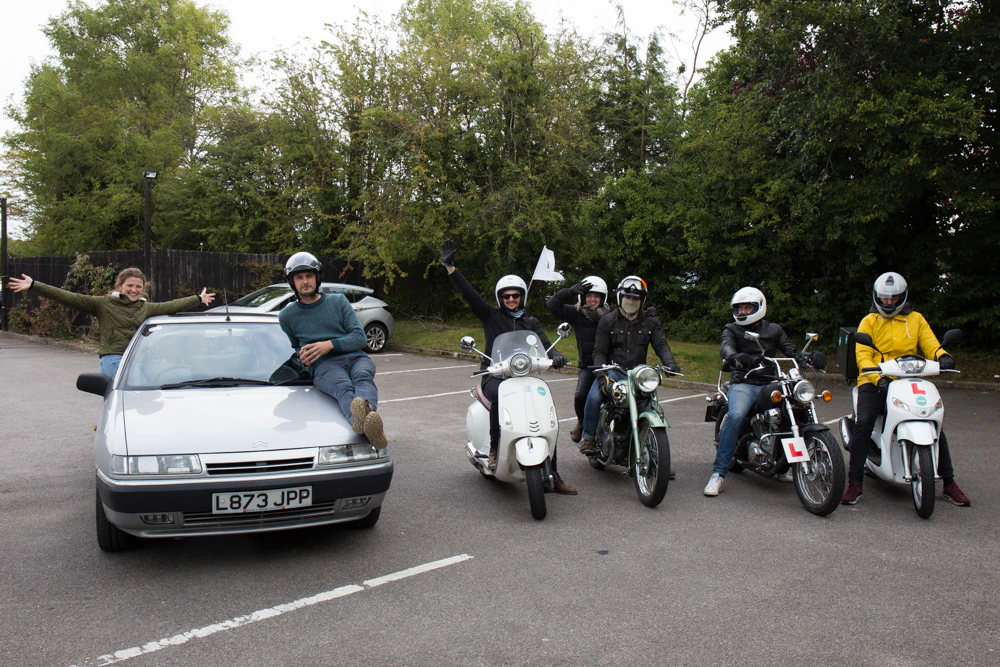back to the blog
Learning to Ride a Motorbike with a Full Car Licence

Tony W · February 28, 2020
So, you’re already getting about on four wheels but the lure of the two-wheeled wind in your face lifestyle is just too tempting to resist. What are your options?
If you passed your driving test before the 1st February 2001 you are entitled to ride a 50cc moped on the road without L plates and without any further training whatsoever. For anyone who passed their driving test after that date, they will have to complete a Compulsory Basic Training course (CBT) with a registered training school.
The CBT is exactly as described, it's training rather than a test and is usually completed in a day. You cannot fail a CBT, you just keep training until the instructor is happy that you have reached the required standard. There is also no requirement to take a theory or hazard perception test, however, it is wise to brush up on your highway code. If you are already a car driver this should be second nature.
Once you have passed the CBT you are able to ride a motorbike up to 125cc in capacity, but there are still a few restrictions. You must ride with L plates affixed to the bike, you cannot ride on motorways and you are also not allowed to carry pillion passengers.
The CBT lasts for two years, after this period your CBT certificate will expire and you will have to book in for another course
after that period you must take a refresher course to ensure you are at the required training school standard. It is possible to keep re-taking this course every two years and riding with the restrictions listed earlier. However once the two wheeled bug bites, most people want to move onto getting their full licence and a bigger bike. The beauty is, of course, once you have your full unrestricted licence you can ride whatever you want, large or small.
That's the basics covered, but what if you are a car driver and want to go straight for the bigger bike option? In this scenario there are three licence categories, each with its own restrictions and age requirements;
Category A1 - Age requirement 17+ *CBT, theory test and practical test.
This will allow you to ride a light motorbike of a maximum 11kw of power (up to 125cc.)
Category A2 - Age requirement 19+ - *Requirements dependent on age and route taken.
This will allow you to ride a standard motorcycle up to 35kw of power.
It's common for more powerful motorbikes to be restricted to meet the power requirement, however the motorcycle cannot be derived from a vehicle with more than twice this power. i.e. you cannot restrict a motorcycle that has a standard power output of more than 70kw. There are two routes to an A2 licence, Progressive and Direct Access. The Progressive Access route can be taken if you have held an A1 licence for 2 or more years, (assuming you are older than 21) and requires just the practical test. The Direct Access route can be taken from the age of 19 and requires a CBT, theory tests and a practical test.

Category A - *Age requirement 21 or 24 dependent on access route.
This will allow you to ride an unrestricted motorcycle of any size (including sidecars and trikes). Again there are the same two routes as the A2 licence. If you want to take the Direct access course, you must be 24 years of age or older and it consists of a CBT, Theory Test and the practical test. Progressive access can be taken from 21 years of age assuming you have held an A2 licence for 2 years. In this case just the practical test is required.
The Practical test for all of these categories consists of two parts. ‘Module 1’ is an off-road riding test where you will be asked to perform a set series of manoeuvres under observation. This takes place within a fenced area at the Test Centre and usually lasts about twenty minutes. The examiner will inform you if you have passed immediately after the test. You can only move onto ‘Module 2’ once you have achieved a pass in ‘Module 1’.
‘Module 2’ is an on-road riding test accompanied by an examiner. Before getting out on the road you will undertake an eyesight test. The examiner will then go through a ‘show me, tell me’ test where you will be asked two vehicle safety questions. The idea is to ascertain that you know how to carry out basic safety checks. The main element of the practical test involves a road ride where the examiner, connected by radio, will ask you to perform a number of manoeuvers. To finish the test you will spend approximately ten minutes riding independently so that the examiner can judge your ability to ride under your own decision making. You will be informed of your result at the end of the test.
The examiner will take you through the assessment sheet highlighting any faults you made, if any. The test Centre will then issue your pass certificate whilst you excitedly wait. You are then free to rip up your L plates and start enjoying the freedom your two-wheeled machine will bring you. The best bit is, you don’t even need to wait for the licence to arrive in the post!


